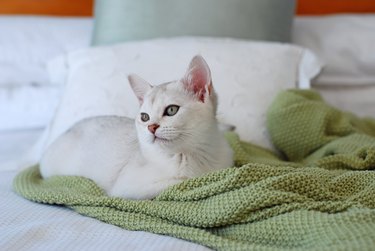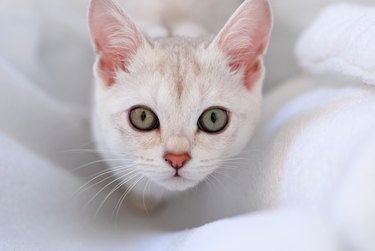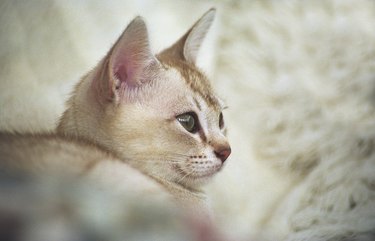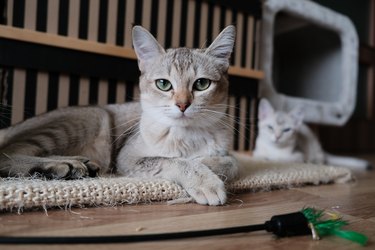
Burmilla cat quick facts
Length: 12 - 16 inches
Weight: Females: 9 - 11 pounds, Males: 11 - 13 pounds
Video of the Day
Video of the Day
Lifespan: 10 - 16 years
Coat length: Short or long
Coloring: Silver white ground color with a shaded or tipped color pattern and any shade of green eyes
Grooming needs: Low to medium
Friendliness: Breed alone is not an accurate predictor of individual cats' personalities. However, burmilla cats are generally regarded as fun-loving and affectionate.
The burmilla cat is a playful and easygoing, medium-sized cat. The breed is a cross between Burmese and Persian cats and they boast a stunning shaded or tipped silver-white coat. The breed has both longhair and shorthair cats, but whichever you choose, know that the breed has only minimal grooming needs. Burmillas are not common in the United States. Be prepared to search for a reputable breeder and patiently wait for kittens to become available. These affectionate cats are worth the wait.

Burmilla cat history
The burmilla cat breed was developed as a cross between Persian and Burmese cats. The first litter of burmilla kittens was born in the United Kingdom in 1981. The initial breeding was unintentional and occurred when a chinchilla Persian male cat, Jemari Sanquist, owned by baroness Miranda Von Kirchberg, mated with a lilac Burmese female, Bambino Lilac Fabergé. The resulting litter of four female kittens displayed a stunning shaded silver color. A breeding program was then started to develop the breed.
Although the breed was started in the UK, the burmilla cat is sometimes considered an Asian breed as both the Persian and Burmese cats originated in Asia. Burmillas are a new breed with the Cat Fanciers' Association (CFA) and they are still quite rare in the United States.
The burmilla coat may be long or short. Longhaired burmillas have feathering on their belly, britches, bib, and tail plume. The undercoat is usually pure white, but some colors have a beige or ivory undercoat. The breed standard recognizes shaded or tipped colors including:
- black
- blue
- caramel
- chocolate
- lilac
- seal sepia
The cats have green eyes and dark rims that give the cats the appearance of wearing eyeliner. It is important to note that kittens may have yellow or gold eye coloring, but their eyes should turn green as the cat matures.
Burmilla cat personality
Burmillas are a laid-back breed with a sweet and affectionate nature. They tend to be social and want to be with the family. Most cats of the breed will enjoy the company of children and other pets. If you live alone, make sure you have plenty of time to spend with your cat. This breed doesn't like to be alone for long periods of time. If you work long hours or travel frequently, this may not be the best breed for your lifestyle.
The cats are also curious, playful, and intelligent. They enjoy playtime with interactive toys and climbing and jumping to high locations throughout the house. You can also teach them tricks using plenty of positive reinforcement.

Burmilla cat lifespan and health issues
A healthy burmilla cat receiving proper care can live well into their teens. While they are generally a healthy breed, some cats may be susceptible to allergies or kidney diseases such as polycystic kidney disease, which causes cysts to build up on the kidneys and decreases kidney function.
Reputable breeders will screen their cats for health problems and avoid breeding any cat that is suffering from or shown to be a carrier of a hereditary disease.
The CFA still allows breeders to outcross burmillas to European Burmese cats and Persian cats in the silver and golden divisions. Breeders should also make sure these cats have been thoroughly screened so that new hereditary problems aren't introduced to the burmilla breed. Some health problems that may affect the Burmese breed, for example, include:
- diabetes mellitus
- hypokalaemic polymyopathy
- feline orofacial pain syndrome
Burmilla cat grooming and care
Burmilla cats are generally low maintenance and require only minimal grooming. Weekly brushing is all that is needed for your shorthaired burmilla. Even longhair burmillas rarely have trouble with matting due to their semi-longhair, silky coat. Though more frequent brushing may be needed to keep the hair free of tangles.
In addition, make sure to complete other regular care and grooming which includes:
- brushing the cat's teeth with a veterinarian-approved toothpaste
- checking and trimming the cat's nails
- checking and cleaning the cat's ears
Feed your cat high-quality commercial cat food as recommended by your veterinarian and make sure they always have access to clean drinking water. Obesity can be a concern, especially as the cats become less active in their senior years. Make sure to encourage regular playtime. Take your cat in for regular veterinary checkups to make sure they are healthy and up-to-date on all of the recommended vaccinations.

Welcoming a new cat into your home
Bringing home your new burmilla kitten is an exciting event. Make sure you are ready by taking the time to cat-proof the home before the kitten's arrival. Keep in mind that burmillas love to climb and jump. Don't forget to check the higher shelves and the tops of the bookshelves and refrigerator.
Set up a room where your new cat can safely adjust to their new environment. Supply the room with everything your new cat may need including:
- food and water
- litter box
- cat tree
- scratching post
- cat toys
Spend plenty of time with your new cat when they arrive, but avoid pressuring them to be petted or explore before they are ready. Allow them to move at their own pace and approach you when they are ready to interact. If you have children and other pets, introduce them to the new cat. Supervise their interactions so it is a positive experience — for everyone.
Once your cat is comfortable in the new environment, you can open the door and allow the cat access to more of the home. Before you know it, the social and affectionate burmilla will be an active part of your family.